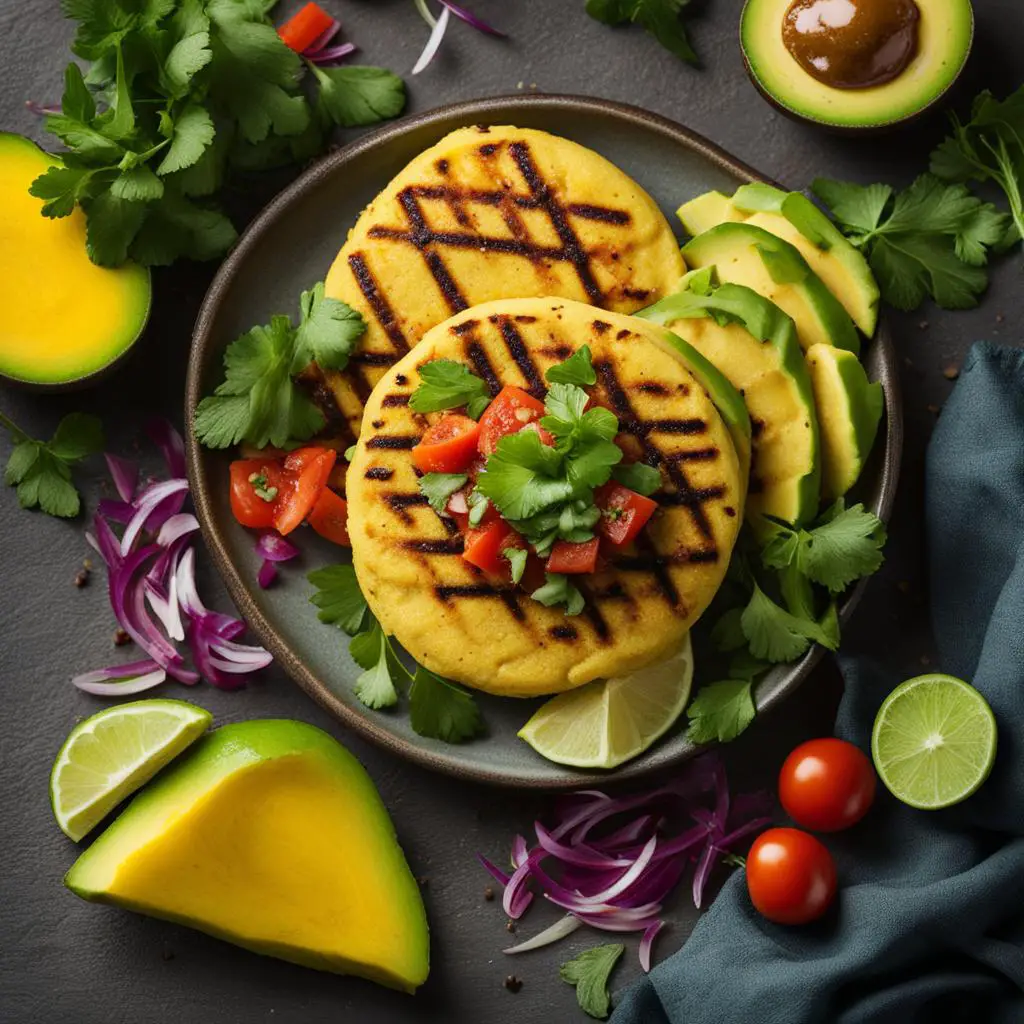Are you looking for delicious vegan recipes that are both satisfying and plant-based? Look no further than vegan arepas! These mouthwatering plant-based arepas are the perfect addition to your recipe collection. Whether you’re a seasoned vegan or just looking for some vegan meal ideas, vegan arepas are sure to be a hit.
These delectable Venezuelan arepas are not only vegan, but they are also gluten-free. Made with just three simple ingredients, they are easy to whip up at home. The combination of pre-cooked cornmeal, water, and salt creates a moist and flavorful arepa that will leave you craving more. Fill them with your favorite stuffing or enjoy them plain as a side dish, either way, they are a tasty and healthy meal option.
Key Takeaways:
- Vegan arepas are a delicious and satisfying plant-based starter.
- They are gluten-free and made with just three simple ingredients.
- Fill them with your favorite stuffing or enjoy them plain.
- Arepas have a long history in both Colombia and Venezuela.
- They can be cooked in various ways, such as grilling, frying, or baking.
Venezuelan Arepas: A History of Corn Griddle Cakes
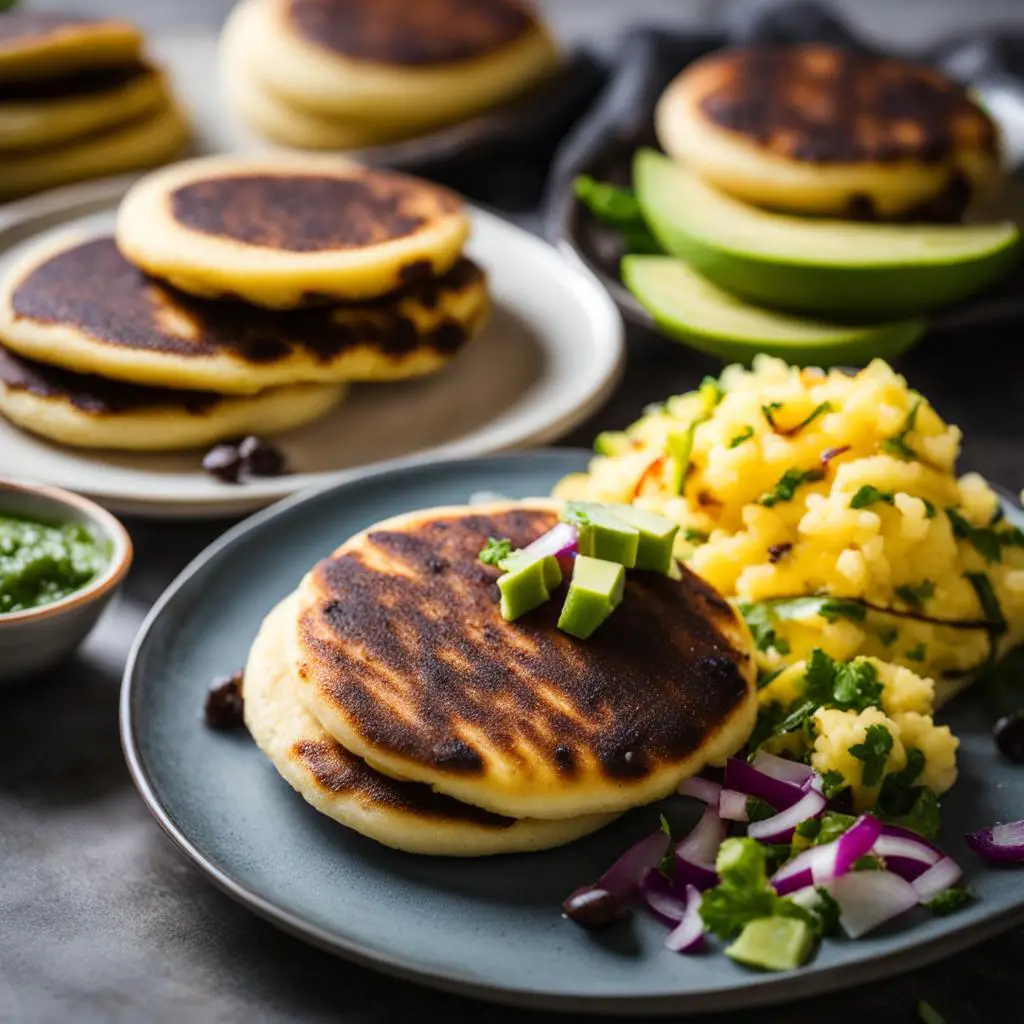
Discover the rich history and culinary heritage behind Venezuelan arepas, the beloved corn griddle cakes that have been a staple in Venezuelan cuisine for centuries. These mouthwatering delights have captivated taste buds around the world with their unique flavors and versatility.
Origin and Cultural Significance
The origins of arepas can be traced back to the indigenous tribes of Venezuela, who used corn as a primary food source. The traditional preparation method involved grinding the corn into a fine flour, known as masa harina, which was then mixed with water and salt to form a dough. The dough was shaped into discs and cooked on a griddle or skillet until golden brown.
“Arepas are not just a food, they represent our cultural identity and history. They are a symbol of our connection to the land and the traditions passed down through generations.” – Maria Lopez, Venezuelan Chef
Over time, arepas evolved and became a popular street food in Venezuela, with vendors offering various fillings such as shredded meat, cheese, avocado, and beans. Today, arepas are a cherished part of Venezuelan cuisine, enjoyed by people of all ages and backgrounds.
Colombian Arepas: Differences in Flavor and Texture
While Venezuelan arepas have gained international recognition, their Colombian counterparts also have a distinct place in Latin American cuisine. Colombian arepas are generally thinner and sweeter compared to the Venezuelan version. They are often stuffed with cheese, meat, eggs, or a combination of ingredients.
| Characteristics | Venezuelan Arepas | Colombian Arepas |
|---|---|---|
| Size | Smaller and thicker | Thin and larger |
| Texture | Crisp on the outside, moist on the inside | Slightly crisp throughout |
| Taste | Neutral | Slightly sweeter |
The differences in flavor and texture between Venezuelan and Colombian arepas highlight the diversity of Latin American cuisine and the varied regional interpretations of this beloved dish.
Next time you take a bite of an arepa, savor the history and cultural significance that these humble corn griddle cakes carry. Whether you prefer the Venezuelan or Colombian style, one thing is certain: arepas are a delicious and unforgettable culinary experience.
How to Make Arepas?

Are you ready to embark on a culinary journey to create your own delicious arepas? Making arepas at home is a simple process that requires just a few ingredients and some basic cooking skills. Let’s dive into the steps and techniques to master the art of crafting these mouthwatering corn griddle cakes.
Preparing the Arepa Dough
The first step in making arepas is to create the dough. Start by combining pre-cooked cornmeal, water, and a pinch of salt in a mixing bowl. Mix the ingredients until a smooth dough is formed. If the dough feels too dry, you can gradually add more water until it reaches the right consistency. On the other hand, if the dough is too wet, add a bit more cornmeal to achieve the desired texture.
Shaping and Cooking the Arepas
Once the dough is ready, it’s time to shape the arepas. Take a portion of the dough and roll it into a ball, then flatten it into a disc shape, about ½ inch thick. Repeat this process with the remaining dough. Now, heat a nonstick griddle or skillet over medium heat and place the arepas on the hot surface. Cook them for approximately 4-5 minutes on each side or until they develop a golden-brown crust.
Filling and Serving Arepas
Now comes the fun part – filling the arepas with your favorite ingredients! Arepas can be filled with a wide range of fillings, including beans, cheese, avocado, vegetables, meats, and more. Get creative and experiment with different combinations to find your perfect flavor profile. Once your arepas are filled, they are ready to be enjoyed as a hearty and satisfying meal.
Recipe Notes, Arepa Storage, and Reheating
Here are a few important tips to keep in mind when making arepas:
- Ensure the dough is well-mixed and has the right consistency. It should hold together without being too sticky or dry.
- Use a nonstick griddle or skillet to prevent the arepas from sticking to the cooking surface.
- If you prefer a crispy exterior, you can brush the arepas with a little bit of oil before cooking them.
- To store leftover arepas, let them cool completely and place them in an airtight container. They can be stored in the refrigerator for up to 3 days or frozen for longer-term storage.
- When reheating arepas, you can use a toaster, oven, or skillet to regain their delicious texture. Make sure to heat them thoroughly before serving.
Now that you have the know-how to make your own arepas, it’s time to put your culinary skills to the test. Gather your ingredients and get ready to savor the delightful flavors of homemade arepas!
Global Variations of Arepas
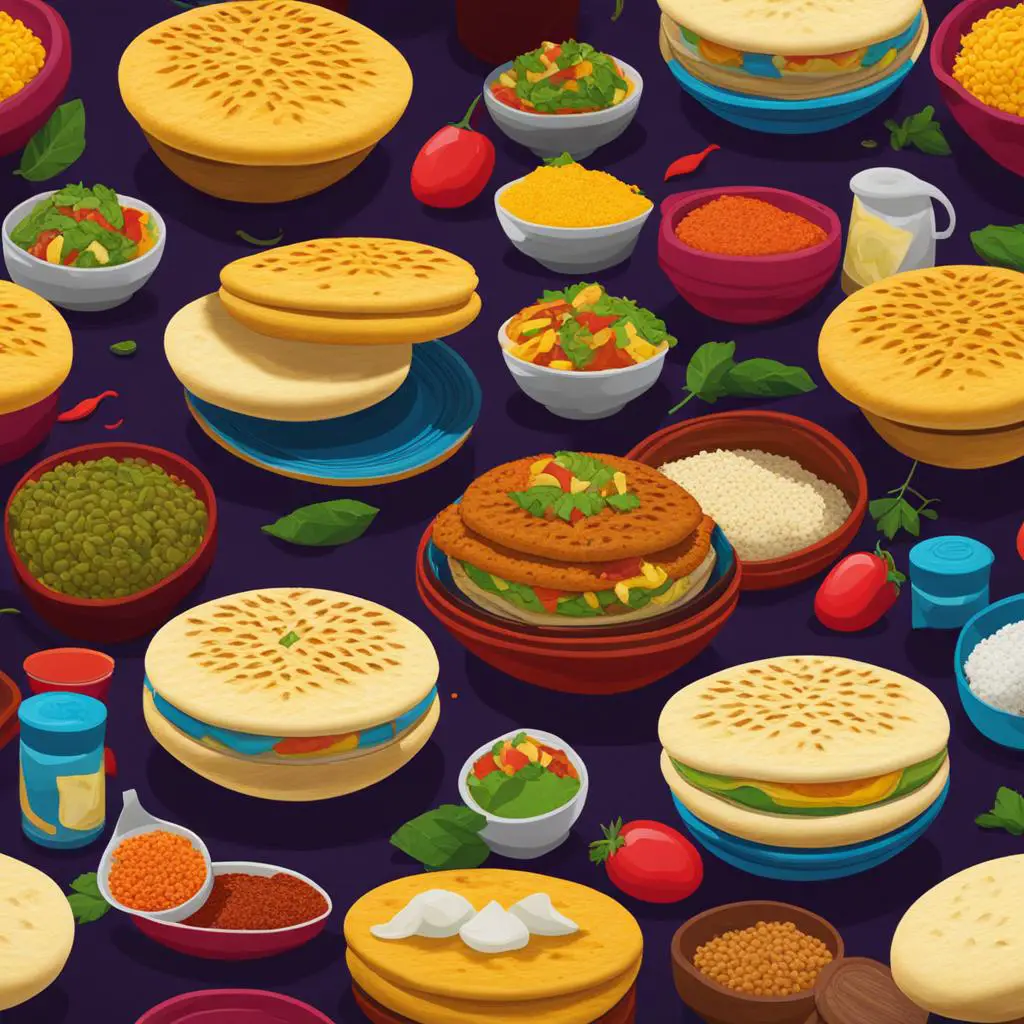
When it comes to arepas, the culinary possibilities are endless. These delicious corn griddle cakes have not only gained popularity in Colombia and Venezuela but have also made their way into street food culture around the world. From New York City to Mexico, different countries have put their own unique spin on this versatile dish. Let’s take a closer look at some global variations of arepas that you can explore.
Vegan Arepas Recipes
If you’re a vegan, you’ll be happy to know that there are plenty of mouthwatering vegan arepas recipes to try. One popular variation can be found in New York City, where vegan hot dogs are wrapped in arepas and topped with sauerkraut, onions, and ketchup. This fusion of flavors offers a delightful twist on the traditional arepa.
In Mexico and major U.S. cities, you can find a unique take on arepas with Mexican fruit salad. This refreshing dish is served with optional chili-pepper powder, adding a kick of flavor to the already vibrant mix of fruits. It’s a perfect choice for those craving a light and fruity arepa experience.
A Tour of Global Arepas
As you explore the world of arepas, you’ll come across international variations that will make your taste buds tingle with excitement. In Thailand, for example, you can enjoy a fusion of flavors with Pad Thai arepas. These arepas feature the iconic Thai noodle dish as a filling, combining the best of both worlds into one delicious package.
Another delightful variation can be found in Colombia, where grilled sweet corn arepas are served with vegan Parmesan cheese, mayonnaise, cilantro, and a zesty squeeze of lemon juice. This combination of flavors creates a mouthwatering explosion of taste that will leave you craving for more.
| Country | Variation |
|---|---|
| New York City | Vegan Hot Dog Arepas |
| Mexico | Mexican Fruit Salad Arepas |
| Thailand | Pad Thai Arepas |
| Colombia | Grilled Sweet Corn Arepas |
These are just a few examples of the global variations of arepas that you can discover. Each country adds its own unique twist to this beloved dish, resulting in a diverse range of flavors and culinary experiences. So, the next time you’re in the mood for something different, why not try a new twist on the traditional arepa? You might just discover a new favorite culinary delight.
Arepas vs. Other Latin American Dishes
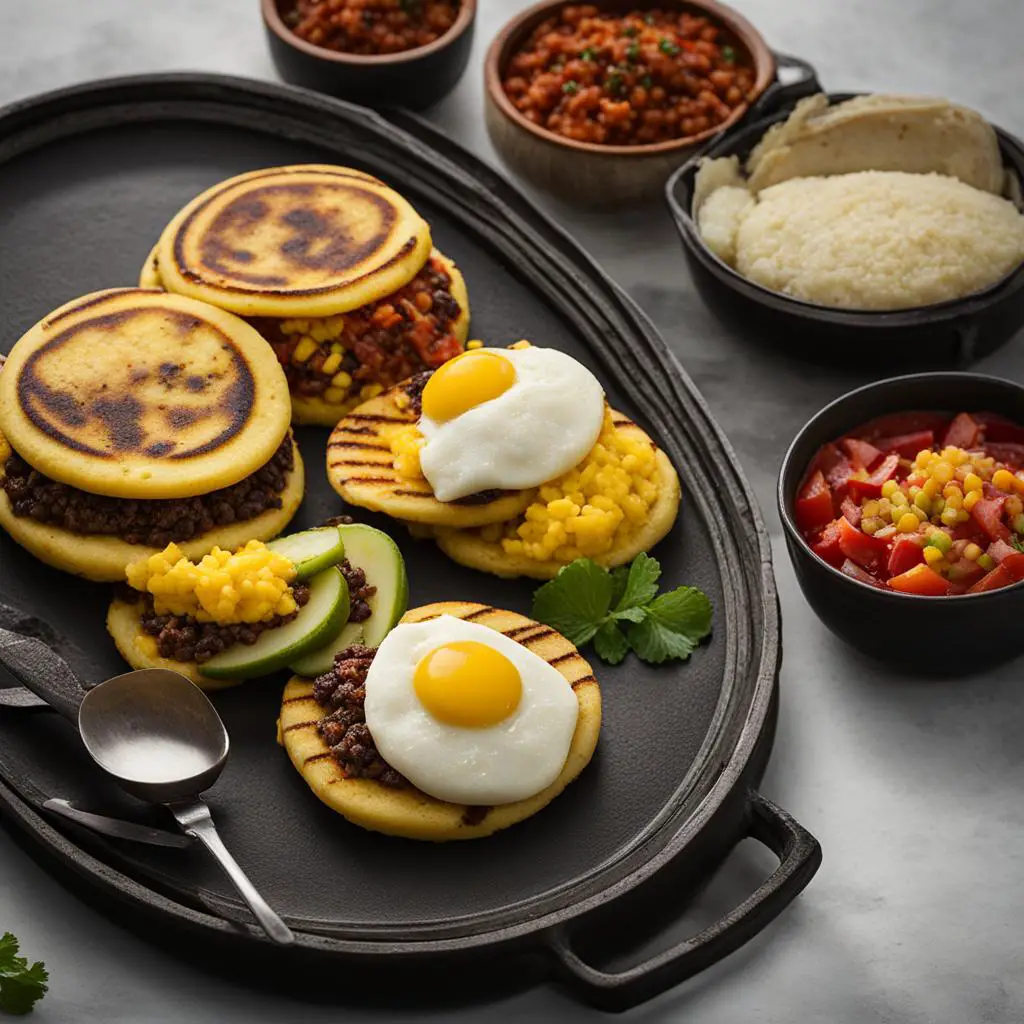
When it comes to Latin American cuisine, there are several delicious dishes that often get compared to arepas. Let’s take a closer look at the differences between arepas and some other popular Latin American dishes like pupusas, gorditas, and empanadas.
Pupusas
Pupusas are thick corn tortillas that originated in El Salvador. They are made from a dough of masa harina, a special type of corn flour. Pupusas are typically stuffed with a savory filling like cheese, beans, or meat, and then grilled or fried until crispy on the outside. Unlike arepas, which are made with pre-cooked cornmeal, pupusas have a distinct texture and flavor that is unique to El Salvadoran cuisine.
Gorditas
Gorditas are another popular dish in Latin America, particularly in Mexico. They are made from a dough similar to that of pupusas, but gorditas are typically made with wheat flour or masa harina mixed with fat like lard or vegetable shortening. The dough is then shaped into thick discs and cooked on a griddle or skillet. Gorditas are often filled with a variety of ingredients like cheese, meat, or beans. While they may share some similarities with arepas in terms of shape and filling options, the use of different types of dough and cooking methods give gorditas a distinct taste and texture.
Empanadas
Empanadas are a staple in many Latin American countries, including Colombia and Venezuela. These tasty pastries are made by folding dough around a filling, which can vary from savory to sweet. Empanada dough is typically made with wheat flour or cornmeal and can be baked or fried until golden and crispy. While both arepas and empanadas can be filled with similar ingredients, their preparation and presentation differ. Arepas are a type of bread, while empanadas are more like turnovers or hand pies. The doughs used for arepas and empanadas also have different textures and flavors, giving each dish its own unique appeal.
All of these Latin American dishes have their own distinct flavors, textures, and cultural significance. While arepas may share similarities with pupusas, gorditas, and empanadas, they stand out as a unique and delicious option in their own right. So why not try them all and experience the rich culinary diversity of Latin American cuisine?
Arepas – A Gluten-Free and Vegan Option
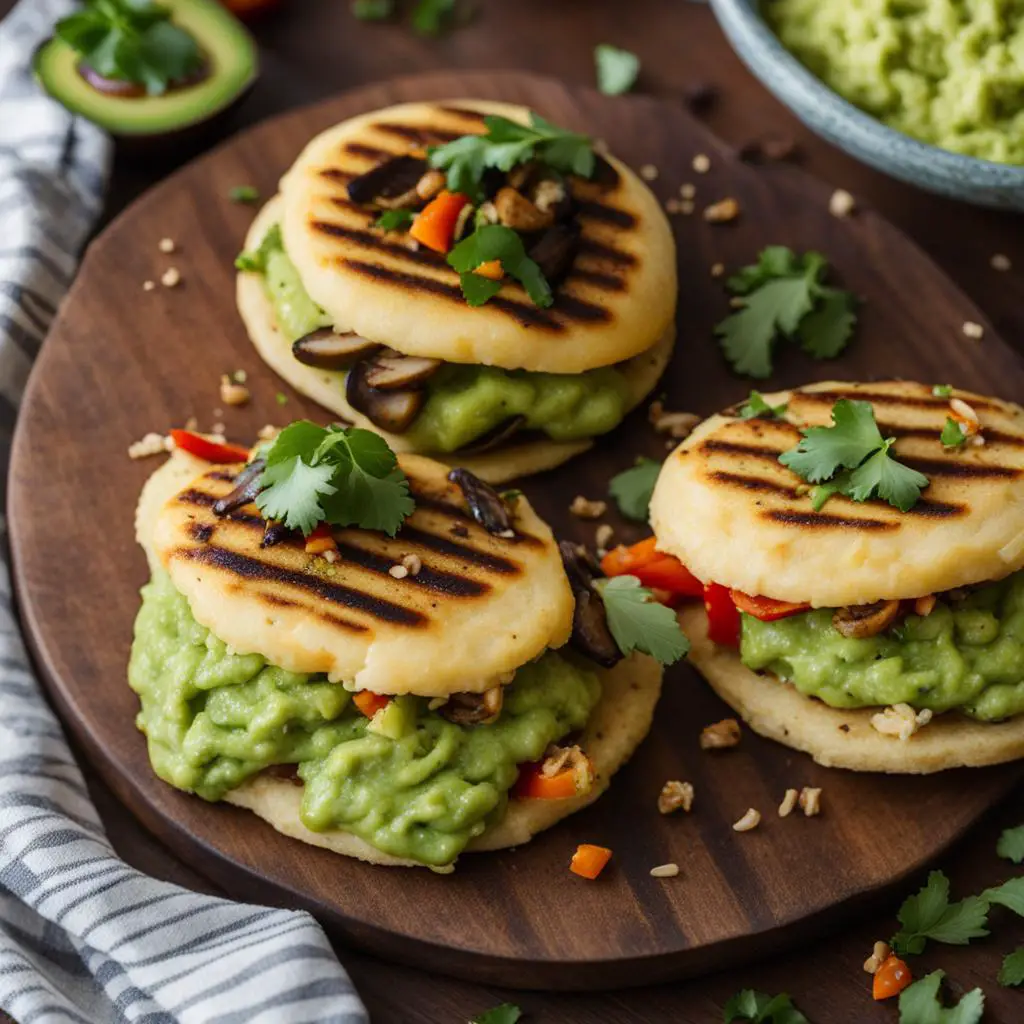
Arepas are not only delicious and versatile, but they are also a fantastic option for those following a gluten-free diet. Made from cornmeal, which is naturally gluten-free, arepas provide a safe and satisfying alternative to traditional bread and other gluten-containing foods. With their crispy exterior and moist, pillowy texture on the inside, arepas offer a delightful culinary experience that will leave you wanting more.
In addition to being gluten-free, arepas also offer several nutritional benefits. Cornmeal, the main ingredient in arepas, is a rich source of protein and dietary fiber. Protein is essential for building and repairing tissues, while fiber helps to support a healthy digestive system and can aid in weight management. By enjoying arepas as part of your diet, you can feel confident that you are nourishing your body with wholesome and nutritious ingredients.
“Arepas are a highly versatile and customizable food that can be filled with a wide variety of plant-based ingredients,” says nutritionist Jane Smith. “You can stuff them with beans, vegetables, plant-based proteins, or your favorite fillings to enhance their nutritional value. This makes arepas a great option for those looking to incorporate more plant-based foods into their diet.”
Whether you are following a gluten-free lifestyle or simply looking for a delicious and healthy meal option, arepas are the perfect choice. Their natural gluten-free nature combined with their nutritional benefits make them a standout among other traditional Latin American dishes. So why not give arepas a try and discover a whole new world of flavors and textures?
Table: Nutritional Comparison of Arepas and Bread
| Arepas (100g) | White Bread (100g) | |
|---|---|---|
| Calories | 198 | 266 |
| Protein (g) | 4.2 | 8.5 |
| Total Fat (g) | 1.4 | 3.3 |
| Carbohydrates (g) | 42.7 | 49.8 |
| Dietary Fiber (g) | 3.6 | 2.7 |
| Sugar (g) | 0.7 | 4.1 |
As the table above demonstrates, arepas offer a lower calorie and fat content compared to white bread. They also provide a good amount of protein and dietary fiber, making them a more nutritious choice. So why not swap out your regular bread for mouthwatering arepas and enjoy a gluten-free feast that your taste buds and body will thank you for?
Conclusion
So, you’ve reached the end of our journey into the delectable world of vegan arepas, the plant-based starters that will make your taste buds dance with joy. These gluten-free delights are not only a feast for the eyes but also a wholesome option for those following a gluten-free diet.
With their crunchy exterior and moist interior, vegan arepas are the perfect canvas for your culinary creativity. Fill them with your favorite plant-based ingredients, whether it’s savory beans, gooey vegan cheese, or a medley of fresh veggies. The possibilities are endless!
By incorporating vegan arepas into your meal rotation, you’re not only treating yourself to a delicious and satisfying dish but also embracing the world of Latin American cuisine. So why not try your hand at making these flavorful treats in the comfort of your own kitchen? Trust us, your taste buds will thank you!
So, next time you’re in the mood for a plant-based starter that’s both gluten-free and bursting with flavor, remember the humble yet incredible vegan arepa. Give it a try, and let your taste buds embark on a delightful adventure!
FAQ
What are arepas?
Arepas are corn griddle cakes that are popular in both Colombia and Venezuela. They are made from pre-cooked cornmeal and can be served with a variety of toppings or fillings.
How do you make arepas?
To make arepas, mix cornmeal dough with water and salt until a dough is formed. Shape the dough into a circular disc and cook on a griddle or skillet until crisp on the outside and moist on the inside.
What can you fill arepas with?
Arepas can be filled with a variety of ingredients such as beans, cheese, or your favorite fillings. The options are endless!
Can arepas be stored and reheated?
Yes, arepas can be stored in an airtight container in the refrigerator or freezer. To reheat, simply pop them in the oven until warm and crispy.
Are arepas only popular in Colombia and Venezuela?
No, arepas have variations and are enjoyed in other countries around the world. You can find unique variations of arepas in places like New York City, Mexico, and major U.S. cities.
What is the difference between arepas and other Latin American dishes?
While arepas share similarities with dishes like pupusas, gorditas, and empanadas, they each have their own unique characteristics and flavors. Colombian arepas are sweeter and packed with cheese, while Venezuelan arepas are smaller and served stuffed with various fillings.
Are arepas gluten-free and vegan?
Yes, arepas are a great option for those following a gluten-free diet as they are made from cornmeal, which is naturally gluten-free. They can also be vegan when filled with plant-based ingredients.
Why should I try vegan arepas?
Vegan arepas are a delicious and versatile plant-based starter that can be enjoyed by everyone, including those following a gluten-free diet. With their crunchy exterior and moist interior, they are a tasty and healthy addition to any vegan recipe collection.
Welcome to VeganClue - My name is Robert Van De Ville and together with my team we spent hundreds of hours researching the most relevant topics for Vegans and non yet Vegans. Are you looking for more information about Veganism, animal welfare, diet, health, and environmental benefits of the Vegan lifestyle? You are in the right place! Enjoy the site.

